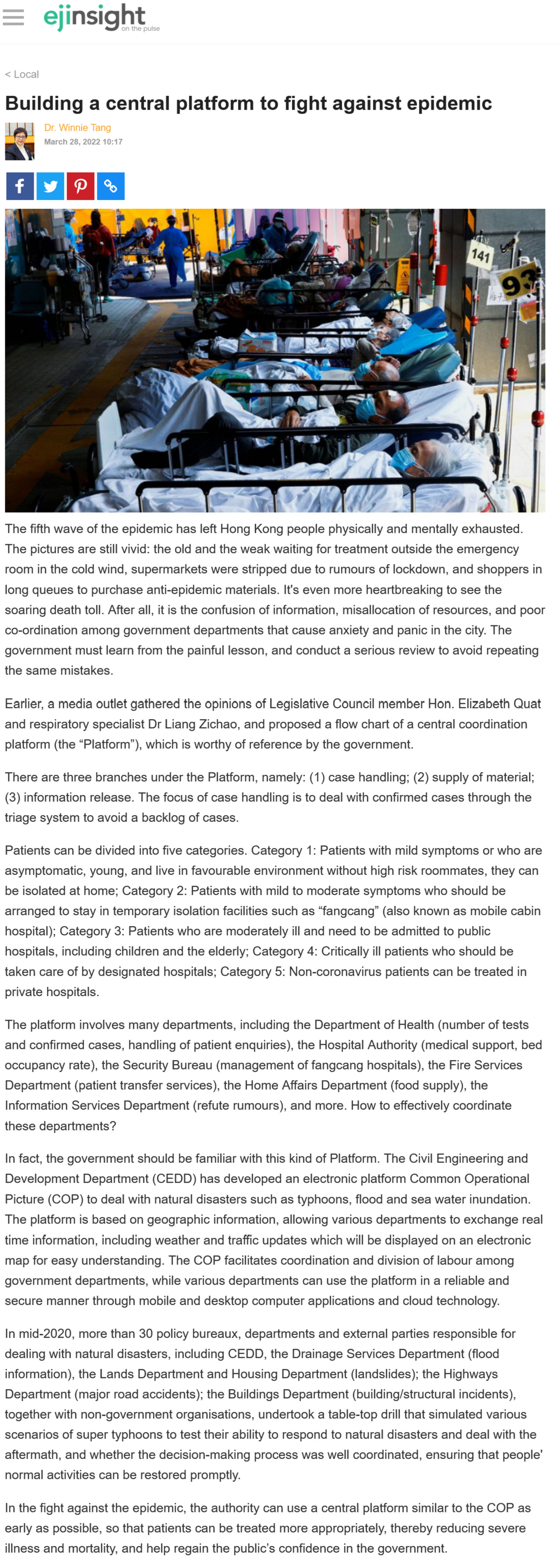網上版請按此

Building a central platform to fight against epidemic
The fifth wave of the epidemic has left Hong Kong people physically and mentally exhausted. The pictures are still vivid: the old and the weak waiting for treatment outside the emergency room in the cold wind, supermarkets were stripped due to rumours of lockdown, and shoppers in long queues to purchase anti-epidemic materials. It's even more heartbreaking to see the soaring death toll. After all, it is the confusion of information, misallocation of resources, and poor co-ordination among government departments that cause anxiety and panic in the city. The government must learn from the painful lesson, and conduct a serious review to avoid repeating the same mistakes.
Earlier, a media outlet gathered the opinions of Legislative Council member Hon. Elizabeth Quat and respiratory specialist Dr Liang Zichao, and proposed a flow chart of a central coordination platform (the "Platform"), which is worthy of reference by the government.
There are three branches under the Platform, namely: (1) case handling; (2) supply of material; (3) information release. The focus of case handling is to deal with confirmed cases through the triage system to avoid a backlog of cases.
Patients can be divided into five categories. Category 1: Patients with mild symptoms or who are asymptomatic, young, and live in favourable environment without high risk roommates, they can be isolated at home; Category 2: Patients with mild to moderate symptoms who should be arranged to stay in temporary isolation facilities such as “fangcang” (also known as mobile cabin hospital); Category 3: Patients who are moderately ill and need to be admitted to public hospitals, including children and the elderly; Category 4: Critically ill patients who should be taken care of by designated hospitals; Category 5: Non-coronavirus patients can be treated in private hospitals.
The platform involves many departments, including the Department of Health (number of tests and confirmed cases, handling of patient enquiries), the Hospital Authority (medical support, bed occupancy rate), the Security Bureau (management of fangcang hospitals), the Fire Services Department (patient transfer services), the Home Affairs Department (food supply), the Information Services Department (refute rumours), and more. How to effectively coordinate these departments?
In fact, the government should be familiar with this kind of Platform. The Civil Engineering and Development Department (CEDD) has developed an electronic platform Common Operational Picture (COP) to deal with natural disasters such as typhoons, flood and sea water inundation. The platform is based on geographic information, allowing various departments to exchange real time information, including weather and traffic updates which will be displayed on an electronic map for easy understanding. The COP facilitates coordination and division of labour among government departments, while various departments can use the platform in a reliable and secure manner through mobile and desktop computer applications and cloud technology.
In mid-2020, more than 30 policy bureaux, departments and external parties responsible for dealing with natural disasters, including CEDD, the Drainage Services Department (flood information), the Lands Department and Housing Department (landslides); the Highways Department (major road accidents); the Buildings Department (building/structural incidents), together with non-government organisations, undertook a table-top drill that simulated various scenarios of super typhoons to test their ability to respond to natural disasters and deal with the aftermath, and whether the decision-making process was well coordinated, ensuring that people' normal activities can be restored promptly.
In the fight against the epidemic, the authority can use a central platform similar to the COP as early as possible, so that patients can be treated more appropriately, thereby reducing severe illness and mortality, and help regain the public's confidence in the government.
Dr. Winnie Tang
Adjunct Professor, Department of Computer Science, Faculty of Engineering; Department of Geography, Faculty of Social Sciences; and Faculty of Architecture, The University of Hong Kong